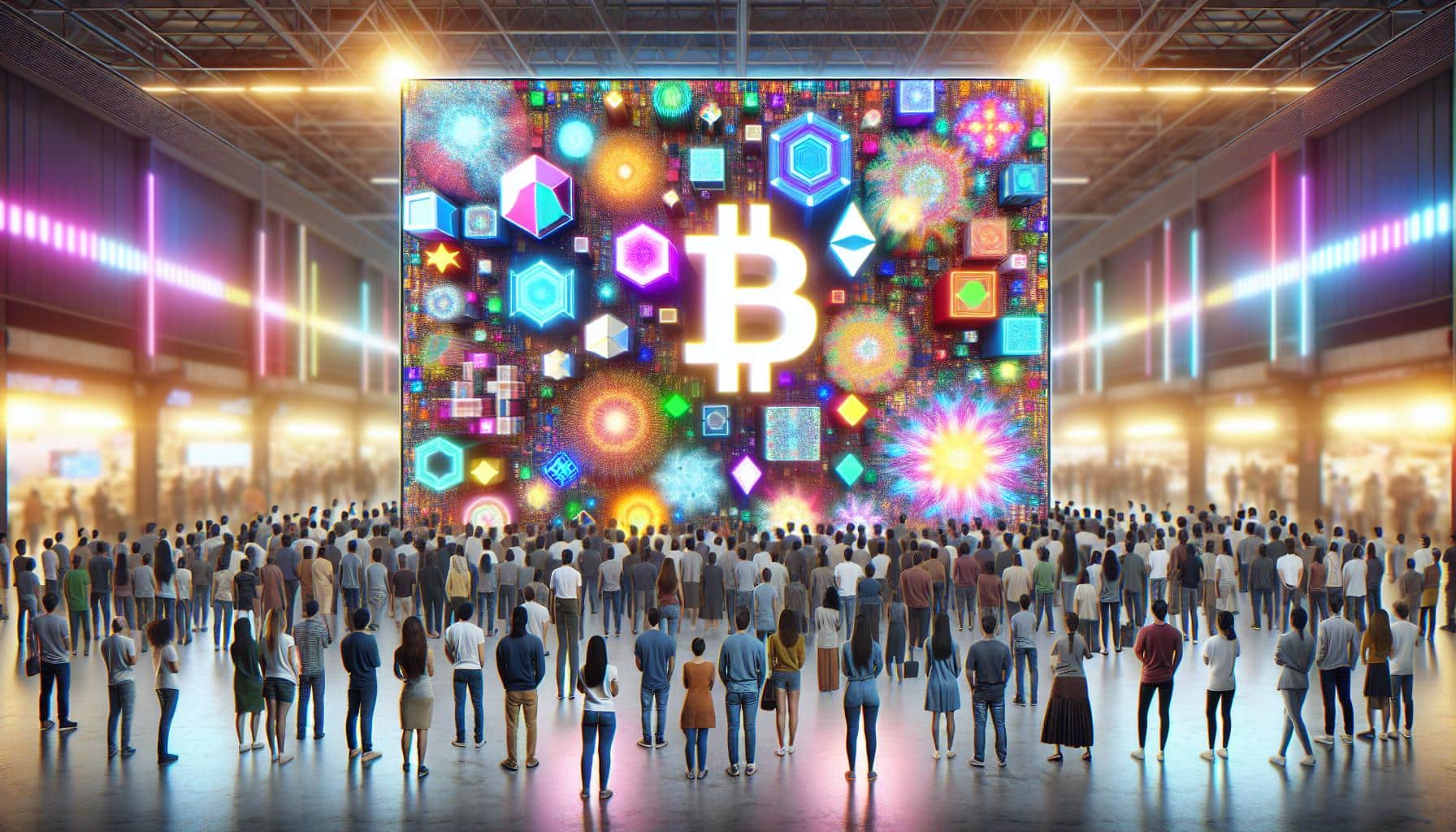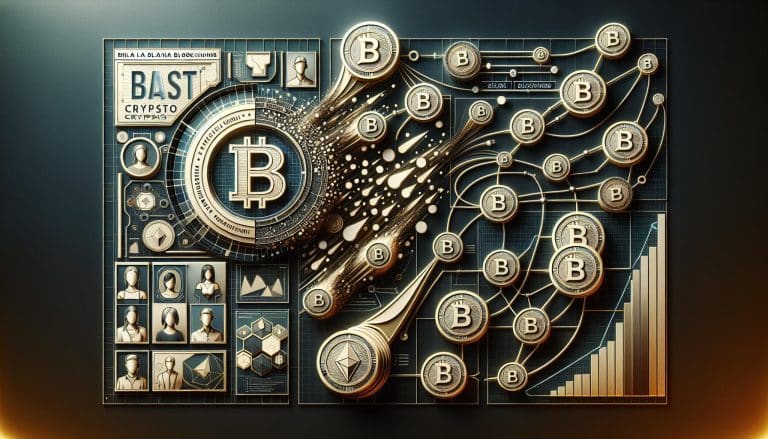Revolutionize Trading: NFT Marketplace Trends
If you’re intrigued by the world of digital assets and blockchain technology, you’ve likely come across the term Non-Fungible Tokens (NFTs). These unique tokens have taken the art, gaming, and collectibles industries by storm, revolutionizing the way we buy, sell, and own digital assets. In this rapidly evolving landscape, the Non-Fungible Token Marketplace serves as the digital hub where creators, collectors, and investors converge to trade these one-of-a-kind digital assets.
Imagine a marketplace where digital art, virtual real estate, and in-game items are bought and sold using blockchain technology, ensuring transparency and authenticity. The Non-Fungible Token Marketplace offers a glimpse into the future of digital ownership, where each token represents a distinct, irreplaceable asset. Whether you’re a digital artist looking to showcase your work or a collector seeking unique digital memorabilia, the NFT marketplace provides a platform for you to explore and engage in this innovative ecosystem.
Understanding Non-Fungible Tokens
In the realm of digital assets, Non-Fungible Tokens (NFTs) have emerged as unique digital tokens that represent ownership of distinctive items on blockchain technology. Unlike cryptocurrencies such as Bitcoin or Ethereum, each NFT is irreplaceable and holds specific information that distinguishes it from others. NFTs are designed to certify the authenticity and ownership of digital assets, ranging from digital art, virtual real estate, to in-game items.
By leveraging the blockchain infrastructure, NFTs ensure transparent and secure transactions within the Non-Fungible Token Marketplace. This marketplace operates as a decentralized platform, allowing creators, collectors, and investors to engage in trading unique digital assets without the need for intermediaries. Artists can tokenize their creations, collectors can own exclusive digital pieces, and investors can participate in the burgeoning NFT market.
In this digital landscape, NFTs have revolutionized the concept of ownership by introducing a new way to buy, sell, and own digital assets securely. Each NFT embodies a digital certificate of ownership that is verifiable on the blockchain, providing a sense of authenticity and scarcity to the digital items traded on the marketplace.
NFTs have gained significant traction in various industries, including art, gaming, and collectibles, offering a plethora of opportunities for creators and enthusiasts to participate in this innovative ecosystem. As you explore the world of NFTs, you’ll discover a treasure trove of unique digital assets that cater to diverse interests and preferences.
NFTs represent a revolutionary shift in the digital ownership landscape, providing a gateway for individuals to engage with exclusive digital content and assets securely. Whether you’re a digital artist looking to tokenize your creations, a collector interested in rare digital items, or an investor seeking opportunities in the NFT market, the Non-Fungible Token Marketplace offers a dynamic space for you to participate in this ever-evolving digital ecosystem.
Evolution of NFT Marketplaces

In the ever-evolving landscape of digital assets, the Non-Fungible Token (NFT) Marketplaces have emerged as a significant part of the crypto ecosystem. These marketplaces provide a platform for creators, collectors, and investors to engage with unique digital items securely. NFTs have revolutionized the concept of ownership, offering transparency and authenticity in transactions.
When it comes to NFT Marketplaces, you can explore a diverse range of digital assets, from digital art to collectibles and even virtual real estate. Unlike traditional markets, NFTs are indivisible and cannot be exchanged on a like-for-like basis due to their unique characteristics. This uniqueness is what makes them appealing to collectors seeking exclusive digital content.
Creators can leverage NFT Marketplaces to tokenize their work and reach a global audience without the need for intermediaries. By minting their creations as NFTs, artists can unlock new revenue streams and establish direct relationships with their fans. For collectors, these marketplaces offer a chance to own one-of-a-kind digital assets, contributing to the growing trend of digital ownership.
In the realm of NFT Marketplaces, you’ll find platforms that facilitate the buying, selling, and trading of these digital tokens. These platforms often provide features such as auction functionalities, secondary marketplaces, and secure digital wallets for storing NFT assets. Whether you’re a digital artist looking to showcase your work or a collector interested in rare digital memorabilia, NFT Marketplaces offer a dynamic space to participate in this burgeoning market.
As the NFT ecosystem continues to expand, innovations such as decentralized marketplaces, NFT fractionalization, and cross-chain compatibility are shaping the future of digital asset trading. By embracing the opportunities presented by NFT Marketplaces, you can immerse yourself in a thriving community of creators and collectors, contributing to the growth and evolution of the digital ownership landscape.
Key Features of NFT Marketplaces
When exploring Non-Fungible Token (NFT) Marketplaces, you’ll find various key features that distinguish these platforms within the digital asset ecosystem. NFT Marketplaces offer a range of functionalities to cater to creators, collectors, and investors interested in unique digital assets. Here are some essential features of NFT Marketplaces to consider:
- Diverse Digital Asset Listings: NFT Marketplaces host a diverse range of digital assets, from art pieces to virtual real estate, providing a broad spectrum of items for individuals to explore and invest in.
- Secure Trading Environment: These platforms prioritize security, offering a safe space for buyers and sellers to engage in transactions with confidence, thanks to blockchain technology ensuring transparency and immutability.
- Direct Creator-Collector Interaction: NFT Marketplaces enable direct relationships between creators and collectors, allowing artists to engage with their audience, tokenize their work, and reach a global fan base more efficiently than traditional channels.
- Auction and Bidding Mechanisms: Many NFT Marketplaces incorporate auction features, allowing users to participate in bidding wars for sought-after digital assets, adding an element of excitement to the trading process.
- Secondary Market Support: These platforms facilitate secondary markets, where users can resell previously purchased NFTs, promoting liquidity and enabling investors to explore a wider array of digital assets.
- Decentralized Marketplace Options: Some NFT Marketplaces operate on decentralized networks, promoting peer-to-peer transactions and eliminating the need for intermediaries, enhancing the decentralized nature of blockchain technology.
- Fractionalization Opportunities: Innovations like NFT fractionalization allow users to own a fraction of high-value assets, making ownership more accessible and enabling broader participation in the marketplace.
Overall, NFT Marketplaces present a dynamic environment for engaging with exclusive digital assets, providing a blend of security, interactivity, and innovation that appeals to a wide range of participants in the evolving landscape of digital ownership.
Trends and Challenges in NFT Marketplaces
As you navigate the world of NFT Marketplaces, there are several trends and challenges that shape the landscape of exclusive digital asset trading. Understanding these dynamics is crucial for engaging effectively in this innovative space.
Diverse Digital Asset Listings
When exploring NFT Marketplaces, you’ll encounter a wide array of digital assets, ranging from digital art and virtual real estate to collectibles and in-game items. This diversity provides you with varied options to explore and invest in, catering to different interests and preferences.
Secure Trading Environments
Security is a top priority in NFT Marketplaces to ensure safe transactions and protect digital assets. Platforms employ robust encryption technologies and decentralized systems to safeguard your ownership rights and provide a secure trading experience.
Direct Creator-Collector Interaction
One of the unique features of NFT Marketplaces is the direct interaction between creators and collectors. This direct relationship allows you to engage with artists, developers, and creators, fostering a sense of community and exclusivity in acquiring digital assets.
Auction and Bidding Mechanisms
Many NFT Marketplaces facilitate auctions and bidding, enabling you to participate in competitive processes to acquire exclusive digital assets. This dynamic environment adds excitement and value to the trading experience.
Secondary Market Support
NFT Marketplaces often support secondary markets where you can resell or trade digital assets after the initial purchase. This feature offers flexibility and liquidity in managing your digital asset portfolio.
Decentralized Marketplace Options
Decentralized NFT Marketplaces provide a peer-to-peer trading environment without centralized control. This setup offers increased transparency, autonomy, and ownership of your digital assets.
Fractionalization Opportunities
Some NFT Marketplaces allow for fractional ownership, enabling you to invest in high-value assets collectively. Fractionalization opens up investment opportunities that may have been inaccessible otherwise.
Navigating the evolving trends and addressing the challenges in NFT Marketplaces can enhance your experience as you engage with exclusive digital assets in the dynamic world of blockchain technology.
Remember to stay informed about the latest developments and best practices in NFT trading to make well-informed decisions and maximize your participation in this innovative marketplace.
Future Outlook of NFT Marketplaces
As the landscape of blockchain technology continues to evolve, the future outlook of Non-Fungible Token (NFT) Marketplaces appears promising. These platforms have become key players in the digital ownership ecosystem, offering creators, collectors, and investors a secure environment for trading unique digital assets.
Diverse Digital Asset Listings
NFT Marketplaces are expected to witness a surge in diverse digital asset listings, ranging from digital art and virtual real estate to collectibles and in-game items. This expansion will provide more opportunities for creators to showcase their work and for collectors to explore a wide array of exclusive digital assets.
Secure Trading Environments
Ensuring secure transactions will remain a top priority for NFT Marketplaces. Advanced security measures and encryption techniques will be implemented to safeguard the authenticity of digital assets and protect the interests of both creators and collectors.
Direct Creator-Collector Interaction
The future of NFT Marketplaces will revolve around fostering direct interaction between creators and collectors. Enhanced communication channels and features will enable creators to engage with their audience, offer insights into their creative process, and establish personal connections with collectors.
Auction and Bidding Mechanisms
Auction and bidding mechanisms will continue to play a significant role in NFT Marketplaces, allowing for dynamic pricing strategies and competitive bidding for exclusive digital assets. These mechanisms add an element of excitement and transparency to the trading process.
Secondary Market Support
Support for the secondary market will be a key focus for NFT Marketplaces, facilitating the resale and exchange of digital assets among collectors. Features like royalties for creators on secondary sales and marketplace integration will drive sustainable growth in the NFT ecosystem.
Decentralized Marketplace Options
The rise of decentralized NFT Marketplaces will offer users increased control over their transactions and assets. Decentralized platforms will emphasize transparency, immutability, and community governance, providing a decentralized alternative to traditional marketplaces.
Fractionalization Opportunities
Fractionalization of NFTs will emerge as a trend, allowing multiple investors to own fractional shares of high-value digital assets. This will democratize access to exclusive NFTs, enable diversified investment opportunities, and expand the reach of NFT ownership.
The future of NFT Marketplaces holds exciting prospects for creators, collectors, and investors, with innovative features, enhanced security measures, and a diverse range of digital assets shaping the evolving landscape of digital ownership.
Conclusion
You’ve explored the dynamic realm of Non-Fungible Token Marketplaces and their profound influence across industries like art, gaming, and collectibles. NFTs have revolutionized digital ownership, creating avenues for creators, collectors, and investors to securely engage with unique digital assets. The future of NFT Marketplaces looks promising, with trends focusing on diverse asset listings, secure trading environments, direct creator-collector interactions, auction mechanisms, secondary market support, decentralized options, and fractionalization opportunities. These advancements are set to elevate the experience of interacting with exclusive digital assets in the blockchain landscape, offering exciting possibilities for stakeholders.
Frequently Asked Questions
What are Non-Fungible Tokens (NFTs)?
NFTs are unique digital tokens that certify ownership on the blockchain. They have transformed digital ownership by providing opportunities for trading exclusive digital assets securely.
Why are NFT Marketplaces important?
NFT Marketplaces are crucial as they offer secure platforms for interacting with unique digital items, enabling creators, collectors, and investors to trade exclusive digital assets safely.
What are the future trends in NFT Marketplaces?
Future trends in NFT Marketplaces include diverse digital asset listings, secure trading environments, direct creator-collector interaction, auction and bidding mechanisms, secondary market support, decentralized marketplace options, and fractionalization opportunities.






 Bitcoin
Bitcoin  Ethereum
Ethereum  Tether
Tether  XRP
XRP  USDC
USDC  Lido Staked Ether
Lido Staked Ether  TRON
TRON  Dogecoin
Dogecoin  Cardano
Cardano  Figure Heloc
Figure Heloc  WhiteBIT Coin
WhiteBIT Coin  Wrapped stETH
Wrapped stETH  Bitcoin Cash
Bitcoin Cash  Wrapped Bitcoin
Wrapped Bitcoin  USDS
USDS  Chainlink
Chainlink  Wrapped eETH
Wrapped eETH  Binance Bridged USDT (BNB Smart Chain)
Binance Bridged USDT (BNB Smart Chain)  LEO Token
LEO Token  WETH
WETH  Hyperliquid
Hyperliquid  Stellar
Stellar  Monero
Monero  Zcash
Zcash  Coinbase Wrapped BTC
Coinbase Wrapped BTC  Ethena USDe
Ethena USDe  Litecoin
Litecoin  Sui
Sui  Avalanche
Avalanche  Hedera
Hedera  Shiba Inu
Shiba Inu  USDT0
USDT0  sUSDS
sUSDS  Dai
Dai  Mantle
Mantle  Toncoin
Toncoin  World Liberty Financial
World Liberty Financial  PayPal USD
PayPal USD  Cronos
Cronos  Ethena Staked USDe
Ethena Staked USDe  Uniswap
Uniswap  Polkadot
Polkadot  Aave
Aave  Bittensor
Bittensor  USD1
USD1  Canton
Canton  MemeCore
MemeCore  Rain
Rain